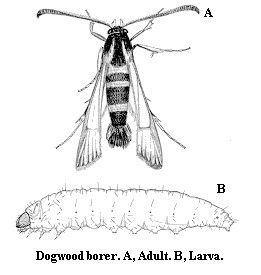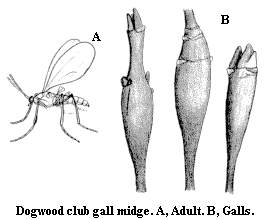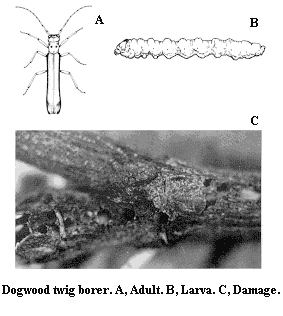Key to Dogwood Pests
The dogwood is one of the most desirable ornamental trees because of its showy inflorescence, attractive foliage, and controlled growth habits. Approximately 4,200,000 dogwood trees are grown in Southern nurseries each year. When planted in full sun or on an unfavorable site, dogwoods may be susceptible to a variety of insect pests, most of which cause damage to the trunk and branches of the tree.
- Dogwood borer – The bark is injured, with fine boring dust on the trunk and branches in late summer.
- Dogwood clubgall midge – Club- or spindle-shaped galls appear near the growing tips of dogwood twigs. Some of the twigs may be dead above the gall, and the tree may be deformed.
- Dogwood twig borer – Leaves wilt on individual twigs; girdled tips drop.
- Seedcorn maggot – Dead or dying flies are attached to the twigs.
Dogwood Borer
Dogwood borer, Synanthedon scitula (Harris), Sesiidae, LEPIDOPTERA
DESCRIPTION
Adult – The basic color of the moth is dark blue, appearing almost black, with occasional yellow markings on the body. The dark thorax is marked with yellow lines and a yellow patch below. The abdomen is dark with yellow on the second and fourth segments. The wings are clear toward the base and have a span of about 15 mm.
Egg – Basically elliptical, the egg is blunt on both ends and very small. When first laid it is pale yellow, turning only slightly darker before the larva hatches.
Larva – Off-white to cream colored, the larva has a reddish-brown head. The prothoracic shield characteristically has two reddish-brown dorsal spots. The larvae range in length from about 1.5 mm when newly hatched to 15 mm or more when mature. There are six stages.
Pupa – The pupa is light brown and about 10 mm long.
BIOLOGY
Distribution – The dogwood borer is found in southeastern Canada and throughout the eastern half of the United States wherever flowering dogwoods are grown.
Host Plants – Flowering dogwood is the preferred host, but the dogwood borer has also been collected from oak chestnut, hickory, elm, willow, and pecan. However, it may be confused with at least two other species, Synanthedon corrusca Edwards and Aegeria pyri Harris.
Damage – On dogwood, attack is apparently confined to the trunk and limbs. In a single year one borer can completely girdle and kill a tree 10 cm in diameter, but death is more often brought about by the combined activity of several larvae and by successive infestations. Cultivated trees are usually more heavily infested than those growing in wooded areas.
Life History – The dogwood borer is the larval stage of a clearwing moth. A native pest, it is known by several other common names: pecan sesia, nine-bark borer, woody gall borer, oak gall borer, and others.
In the South, adult emergence occurs from late April to late October, peaking in mid-May. Eggs are laid singly on bark. A female may lay up to 116 eggs. Incubation usually requires 8 to 9 days. Newly hatched larvae become established only if they encounter a broken bark wound, a cracked callous area, such as a canker, or some site affording immediate protection. Feeding, confined to the cambium and bark, continues until winter. The dogwood borer then hibernates in the larval stage within its tunnel. Pupation takes place the following spring. Although there is only one generation per year, borers may be found in various stages of development throughout most of the year because eggs are laid over a period of several months.
CONTROL
Sprays should be applied in early June and repeated in 10 to 14 days. For specific chemical controls, see the current state extension recommendations.
Dogwood Clubgall Midge
Dogwood clubgall midge, Resseliella clavula (Beutenmuller), Cecidomyiidae, DIPTERA
DESCRIPTION
Adult – The delicate adult is a small fly about 1.5 mm long. The abdomen is bright orange; the thorax is yellow orange or duller. The wings are mottled with varying patches of black and yellow hairs, which in some specimens resemble irregular, black and yellow bands. The male's antennae are about the same length as the body, the joints appearing beadlike. The female's antennae are shorter and less conspicuously adorned.
Larva – The larva is an orange-colored maggot.
BIOLOGY
Distribution – Galls of the dogwood clubgall midge are more common on dogwoods grown as ornamentals than on those growing naturally in the woods.
Host Plants – Flowering dogwood is the only known host for this pest.
Damage – The dogwood clubgall midge causes club- or spindle-shaped tubular swellings (galls) from 13 to 25.5 mm long, which form at the tips or along the stems of dogwood twigs. From 30 to 120 galls per tree have been reported. Some of the twigs may die above the swollen part, and the tree may be deformed if the infestation is heavy.
Life History – The dogwood clubgall was first recorded as a common deformity on flowering dogwood in 1939. In the fall, maggots emerge from the galls by chewing small, round holes through the sides. They drop to the soil under the dogwood trees, where they overwinter. Pupation occurs the following spring. In late spring, adults emerge and lay their eggs among the minute terminal leaves. Usually the eggs are laid on the most vigorous twigs where the nodesare close together in the developing bud. Upon hatching, the maggots work their way into the interior of the leaf base or into petioles at the junction of the apical pair or two pairs of minute terminal leaves. Occasionally, entrance to the midrib may be through adjacent leaf tissue. Feeding causes the formation of an elongate gall, where the maggots live in a central cavity. From 1 to 39 maggots may be found per gall.
CONTROL
Swollen twigs should be cut off and burned while the larvae are present.
Dogwood Twig Borer
Dogwood twig borer, Oberea tripunctata (Swederus), Cerambycidae, COLEOPTERA
DESCRIPTION
Adult – The adult is a slender beetle measuring 10 to 15 mm long and 3 mm wide. The head is dark to almost black. A triangle of three black spots is visible on the top of the thorax. The wing covers are yellow tan, with a narrow, black line on the inner edge and a broader, darker line on the lateral margin.
Larva – When fully grown, the larva is yellowish, legless, and about 19 mm long.
BIOLOGY
Distribution – Wherever flowering dogwoods are grown, the dogwood twig borer is a threat.
Host Plants – Elm, viburnum, azalea, and many fruit trees may be attacked by the dogwood twig borer, though its principal host is the flowering dogwood.
Damage – Wilting leaves on individual twigs or drooping girdled tips usually indicate infestation by this borer.
Life History – The dogwood twig borer is the larval stage of a small, long-horned beetle. It is also known as the elm twig girdler. Seldom appearing in large numbers, adults emerge in early summer. After girdling the tip of a twig, the female deposits her eggs singly in its bark crevices. When an egg hatches, the larva tunnels along the center of the twig, making a series of closely placed holes to remove the boring dust. Portions of the hollowed branch may be internally separated from the plant as the larva moves into the green wood. The winter is usually passed in the pupal stage inside the tunnel.
CONTROL
After wilting occurs in the spring, the twig should be clipped off several inches below the girdled or infested portion and destroyed.
Seedcorn Maggot
Seedcorn maggot, Hylemya platura (Meigan), Anthomyiidae, DIPTERA
DESCRIPTION
Adult – The fly is grayish brown and about 5 mm long.
Larva – When fully grown, the larva is yellowish white. About 6 mm long, it is sharply pointed at the front, legless, and tough skinned.
Pupa – The capsule-like puparium is dark brown and about 5 mm long.
BIOLOGY
Distribution – The species is widely distributed in Europe. First found in this country in 1856 in New York, it has now spread over the entire United States and southern Canada.
Host Plants – The seed attacked by the seedcorn maggot usually fails to germinate. If it does sprout, the plant is weak and sickly. Injury is usually most severe during wet, cold seasons and on land rich in organic matter.
Damage – Wilting leaves on individual twigs or drooping girdled tips usually indicate infestation by this borer.
Life History – The seedcorn maggot does no harm to dogwood trees, but it is a frequently reported guest of dogwood and other ornamental plants. Only the adult is found on dogwood. It is infected by a fungus (Entomophthora), which apparently causes the fly to light on and cling to protruding twigs. It usually dies in the afternoon as its abdomen swells with internal fungal strands. Early the next morning when humidity is high, the fungal spores are released into the air to infect other flies. The dead flies shrivel and eventually fall from the twigs.
Most of the life cycle is spent in the maggot stage in the soil of various field crops. Flies emerge in May to deposit their eggs on seed, on plantlets, or on soil with an abundance of decaying vegetable matter. Upon hatching, the maggots burrow into the seed, often destroying the germ. They develop into pupae inside brown puparia in the soil and emerge as adults 12 to 15 days later. As many as three to five generations occur each year.
CONTROL
On dogwoods and other ornamental shrubs, no control of the adults is necessary since infected adult flies indicate a natural mortality factor at work.
For control of the maggots in field crops, shallow planting in a well-prepared seedbed, sufficiently late for quick germination of the seed, is probably the best means of preventing injury. Land where manure is heavy or where a cover crop is turned under should be plowed early in the fall, if possible, to make it less attractive to the egg laying flies the following spring. Prompt resetting or replanting of the damaged crops will usually give a good stand.
Publication date: Jan. 1, 1993
AG-189
Other Publications in Insect and Related Pests of Shrubs
N.C. Cooperative Extension prohibits discrimination and harassment regardless of age, color, disability, family and marital status, gender identity, national origin, political beliefs, race, religion, sex (including pregnancy), sexual orientation and veteran status.




